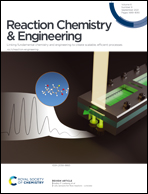Tuning the selectivity of CO2 hydrogenation using ceramic hollow fiber catalytic modules†
Abstract
The unique structural features and advantageous pore distributions of alumina hollow fibers can be exploited to tune the selectivity in heterogeneous catalysis. Formation of a finger-like cavity structure is the unique characteristic of the phase inversion method, which provides a larger surface area to volume ratio desirable for catalytic reactions. This feature, along with a highly porous sandwiched skin layer, makes this architecture superior to conventional powder catalysts or other structured catalyst forms like monoliths. Alumina hollow fibers are prepared by the modified phase inversion method and characterized for their pore size and distribution. Ni metal nanoparticles are uniformly deposited in the Al2O3 hollow fibers to prepare a Ni/Al2O3 catalyst and tested for the CO2 methanation reaction. Suitable reactor and catalyst loading methods are designed and optimized to achieve higher CO2 to methane conversion in a temperature range of 225 to 400 °C. The α-alumina phase, which is usually reported to be a poor support for Ni in CO2 methanation in the conventional fixed bed configuration, showed high activity when modulated as hollow fibers. Also, the selectivity to CH4 is enhanced and minimal CO formation is observed. The kinetic rate expressions are simulated for the prediction of methane and CO gas evolution at the outlet with temperature. The experimental results for the gas composition are in good agreement with the model predictions. The advantage of such a module reactor is explained based on the mass transfer limitations and consequently the reaction time constants arrived at from the predicted gas compositions.



 Please wait while we load your content...
Please wait while we load your content...